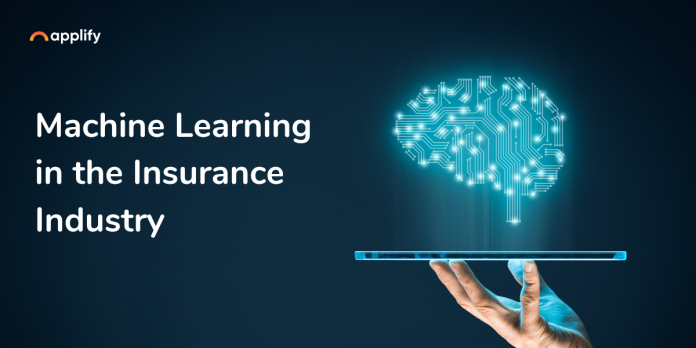Machine learning in insurance applications can be a brilliant use case if implemented in the right way. In this blog, we will explore the benefits of machine learning in insurance and its various applications. But first, let’s briefly discuss machine learning.
What is Machine Learning?
Machine learning involves the use of algorithms that enable computers to learn from and make predictions based on large sets of data. These algorithms can identify patterns, relationships, and trends in data sets that humans may not be able to detect.
In essence, machine learning enables computers to automatically improve their performance on a specific task without being explicitly programmed to do so.
Importance of Machine Learning in the Insurance Industry
The insurance industry is built on the ability to assess and manage risk. And machine learning provides a powerful tool for insurers to achieve these goals. Machine learning algorithms for the insurance industry can analyze vast amounts of data in real-time. Thus, enabling insurers to quickly identify risk factors and potential fraud.
Additionally, machine learning can help insurers better understand their customers’ needs, leading to improved customer service and higher retention rates.
If you already are aware of the benefits, it’s time to consult a digital product development company.
Benefits of Using Machine Learning in Insurance

There are several use cases where machine learning can prove to be a holy grail when it comes to insurance applications.
1. Fraud Detection
Fraud is a significant problem in the insurance industry, with billions of dollars lost each year due to fraudulent claims. It can help insurers detect fraud by analyzing vast amounts of data to identify patterns and anomalies that may indicate fraudulent activity. Machine learning algorithms can analyze data from a variety of sources. This may include claims data, policyholder information, and external data sources such as social media and public records.
Machine learning algorithms can use a variety of techniques to identify potential fraud, including:
- Anomaly Detection: Machine learning algorithms can identify unusual patterns in data that may indicate fraudulent activity. For example, if a policyholder submits a claim for a car accident that occurred 1000 miles away from their home, it may indicate potential fraud.
- Predictive Modeling: Machine learning algorithms can use historical data to predict the likelihood of fraud. For example, if a particular type of claim is frequently linked with fraud, a machine-learning algorithm can be trained to identify similar claims in the future and flag them for further investigation.
- Network Analysis: Machine learning algorithms can analyze relationships between individuals and entities to identify potential fraud rings. For example, if multiple individuals are submitting similar claims from the same location, it may indicate a fraud ring.
Real-life Examples of Machine Learning Fraud Detection in the Insurance Industry
There are many real-life examples of machine learning to detect fraud in the insurance industry.
- Allstate uses machine learning algorithms to analyze claims data to identify potentially fraudulent claims. The algorithms analyze various data points, including policyholder information, claim history, and external data sources, to identify potential fraud. Allstate has reported that the use of machine learning has resulted in significant improvements in fraud detection.
- Another example is State Farm. It uses machine learning algorithms to analyze data from social media and public records to identify potential fraud. The algorithms can identify patterns of behavior that may indicate fraudulent activity. This may include instances such as a policyholder posting pictures of a car accident on social media before submitting a claim for the same accident.
Don’t have an insurance application yet? Here’s a quick read for you to understand more about insurance product development.
2. Risk Assessment
Risk assessment is a critical aspect of the insurance industry. Insurers must accurately assess the risk associated with a particular policy or claim to make informed underwriting decisions. Insurance applications for machine learning can help insurers assess risk by analyzing vast amounts of data to identify patterns and relationships that may indicate higher or lower risk.
Machine learning algorithms can analyze a variety of data points, including historical claims data, policyholder information, and external data sources, to assess risk. Machine learning algorithms can use a variety of techniques to assess risk, including:
- Predictive Modeling: Machine learning algorithms can use historical data to predict the likelihood of future claims. For example, if a particular type of policyholder has a history of making frequent claims, a machine learning algorithm can predict that they are more likely to make a claim in the future.
- Image Analysis: Machine learning algorithms can analyze images to assess risk. For example, if an insurer is assessing the risk associated with insuring a property, a machine learning algorithm can analyze satellite imagery to identify potential risks, such as the property’s proximity to a flood zone or wildfire risk area.
- Natural Language Processing: Machine learning algorithms can analyze text data to assess risk. For example, if an insurer is assessing the risk associated with insuring a business, a machine learning algorithm can analyze the company’s financial statements to identify potential risks.
Real-life Examples of Machine Learning Risk Assessment in the Insurance Industry
- Swiss Re uses machine learning algorithms to analyze various data sources to assess risk. The algorithms analyze a range of data points, including claims data, financial data, and external data sources, to make informed underwriting decisions. Swiss Re has reported that the use of machine learning has resulted in significant improvements in underwriting accuracy and profitability.
- Another example is Lemonade, a digital insurance company that uses machine learning to assess risk in real-time. The company’s AI-powered underwriting model can assess risk in seconds, allowing customers to purchase insurance quickly and easily.
Want to first validate your idea first with a clickable prototype on a similar use case? We are a top-rated mobile app design company in Singapore. Get in touch with our experts today.
3. Customer Service
Customer service is a crucial aspect of the insurance industry. Customers want to feel heard, understood, and supported throughout their interactions with insurance companies. Machine learning can improve customer service by analyzing customer interactions to identify common issues, concerns, and questions.
Machine learning algorithms can use a variety of techniques to improve customer service, including:
- Natural Language Processing: Machine learning algorithms can analyze customer interactions to identify common language patterns and sentiments. This information can help insurers identify common issues and concerns and develop targeted solutions to address them.
- Chatbots: Machine learning algorithms can power chatbots, which can provide customers with quick, personalized responses to their inquiries. Chatbots can handle simple inquiries, such as policy questions or claim status updates, freeing customer service representatives to handle more complex issues.
- Personalization: Machine learning algorithms can analyze customer data to provide personalized recommendations and solutions. For example, if a policyholder has a history of submitting claims related to a particular type of risk, a machine learning algorithm can recommend policy upgrades or additional coverage options to address that risk.
Real-life Examples of Machine Learning Customer Service in the Insurance Industry
- MetLife uses machine learning algorithms to power its customer service chatbot. The chatbot can handle a range of customer inquiries, including policy questions and claim status updates, providing customers with quick, personalized responses.
- Another example is Allianz, which uses machine learning algorithms to analyze customer interactions to identify common issues and concerns. The company uses this information to develop targeted solutions and improve customer service.
Building such complex digital use cases requires an experienced and reliable team of tech experts. Get in touch today and get a free quote to hire app developers in Singapore.
4. Claims Management
Claims management is a critical function of the insurance industry. Insurers need to process claims quickly and accurately to provide policyholders with the support they need when they experience a loss. Insurance applications for machine learning can help insurers with claims management by automating many of the processes involved in claim processing, reducing the time and resources required to process claims.
Machine learning algorithms can use a variety of techniques to improve claims management, including:
- Claims Prediction: Machine learning algorithms can predict the likelihood of a claim being fraudulent or inaccurate, allowing insurers to prioritize claims that are more likely to be valid.
- Image Analysis: Machine learning algorithms can analyze images, such as photos of the damage, to assess the extent of the loss and expedite the claims process.
- Claims Automation: Machine learning algorithms can automate many of the processes involved in claims management, including claims intake, adjudication, and payment processing, reducing the time and resources required to process claims.
Real-life Examples of Machine Learning Claim Management in the Insurance Industry
- Allstate uses machine learning algorithms to predict the likelihood of fraudulent claims. The algorithms analyze a range of data points, including claims history and external data sources, to identify claims that may be fraudulent or inaccurate. This allows Allstate to prioritize the claims that are more likely to be valid and provide policyholders with faster, more accurate claims processing.
- Another example is State Farm, which uses machine learning algorithms to automate the claims process. The algorithms can analyze data from multiple sources, including claims forms and photos of the damage, to expedite the claims process and reduce the time and resources required to process claims.
Challenges of Implementing Machine Learning in Insurance
Sure, all the benefits of implementing machine learning for the insurance industry sound great. But you should also consider the challenges it may pose.
1. Data Quality
One of the biggest challenges is ensuring the quality of the data. Machine learning algorithms rely on large amounts of high-quality data to identify patterns and make accurate predictions. However, insurance data can be complex and messy, making it difficult to extract meaningful insights.
To overcome this challenge, insurers must invest in data cleansing and preprocessing techniques to ensure that the data is accurate and relevant. This may involve using data from multiple sources, cleaning and normalizing the data, and applying feature engineering techniques to extract relevant features from the data.
2. Regulatory and Legal Challenges
The insurance industry is heavily regulated, and there are many legal and regulatory requirements to consider when implementing machine learning. For example, insurers must ensure that their use of machine learning does not violate privacy laws or discrimination laws. They must also ensure that their algorithms are transparent and explainable so that regulators and policyholders can understand how decisions are being made.
To overcome these challenges, insurers must work closely with regulators and legal experts to ensure that their use of machine learning is compliant with relevant laws and regulations.
3. Privacy Concerns
The use of machine learning in insurance raises significant privacy concerns. Machine learning algorithms rely on large amounts of data, including sensitive personal information about policyholders. Insurers must ensure that they are collecting and using this data in a responsible and ethical manner and that they are protecting policyholder privacy.
To overcome these challenges, insurers must implement strong data governance policies and procedures. These policies will ensure that data is collected, processed, and used in a responsible and ethical manner. They must also ensure that they have appropriate data security and privacy measures in place to protect policyholder data from unauthorized access or use.
Overall, while machine learning can offer many benefits to the insurance industry, it is important for insurers to carefully consider and address these challenges to ensure that their use of machine learning is ethical, compliant, and effective.
Future
As the insurance industry continues to evolve, the use of machine learning is likely to become increasingly prevalent. Machine learning has the potential to transform the insurance industry by improving risk assessment, reducing fraud, enhancing customer service, and streamlining claims management.
1. Growth Potential
The growth potential of machine learning in the insurance industry is significant. According to a report by Accenture, the use of artificial intelligence (AI) in the insurance industry is projected to generate $1.1 trillion in value by 2030. Machine learning is a key component of AI, and as such, is likely to play a major role in this growth.
One area where machine learning is likely to see significant growth is in the use of telematics data.
Machine learning can analyze telematics data collected from devices installed in vehicles to identify patterns and enable insurers to make more informed decisions, accurately assess risk, and provide personalized insurance rates.
2. Innovation Opportunities
The use of machine learning in insurance also presents many opportunities for innovation. For example, tech companies can use machine learning to develop more accurate and personalized insurance products, based on individual risk profiles. It can also improve claims processing and reduce fraud, which can help insurers save time and money.
Another area where machine learning can drive innovation in insurance is in the development of chatbots and virtual assistants for customer service. These tools can help insurers provide more responsive and personalized service to policyholders, while also reducing the workload on customer service representatives.
Conclusion
Insurance applications for machine learning can revolutionize how insurers assess risk, detect fraud, manage claims, and provide customer service. The benefits of machine learning are clear, including improved accuracy, efficiency, and cost savings.
To take advantage of these benefits, it is important for the insurance industry to embrace machine learning and invest in the necessary infrastructure, tools, and talent to make it work effectively. Insurers should prioritize data quality, regulatory compliance, and transparency to ensure their machine-learning algorithms are accurate, fair, and unbiased.
In addition, insurers should collaborate with technology providers, academic institutions, and other stakeholders to drive innovation and push the boundaries of what is possible with machine learning in insurance. By working together, the industry can overcome the challenges and limitations of machine learning and unlock its full potential.









